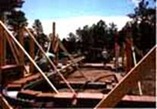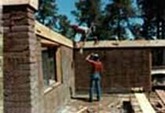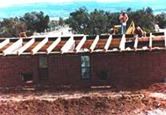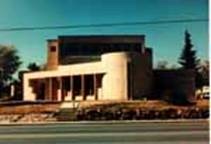
EARTHEN CONSTRUCTION –
ALTERNATE LOW COST HOUSING
Earth is the oldest building material. It use is as widespread as humanity as well. Nearly half the world’s population lives in structures made with some kind of earthen construction technique. To this day, earthen construction remains the most economically viable and popular method of construction. Earth construction technologies are generally used to construct homes. Other structures such as offices, stores, warehouses etc can also be made using earth. The most obvious advantage of earth construction is the abundance of the raw material – earth. Other advantages of earthen construction include:
- High thermal insulating properties
- High sound insulation
- Not susceptible to insects or rodents
- No waste generated during construction
- Inert – contains no toxic substances
- Construction is inexpensive and simple
- High workability and flexibility
- Fire resistant
The following are among the more popular types of earthen construction:
- Adobe
- Rammed earth
- Compressed earth blocks
Adobe:
Adobe is air/sun dried brick from mud composed of inorganic soil and sand. The soil must have minimum clay content of 10%. Fibers such as straw may also be added to increasing the stability of the block as work well as binders. An adobe brick is typically 10 to 12 inches and weighs between 30 to 50 pounds (Allen & Thallon, 2001). The bricks are stacked one over the other and bonded using a mud mortar. Additives such as asphalt and flyash help to minimize its susceptibility to moisture while giving it additional strength.
As adobe structures are essentially stacks of mud, they require protection from water, especially rainfall that can wash the structure away if due precautions are not taken. Some of the steps that can be taken to protect adobe structures are:
- Placing walls on concrete or stone foundations
- Using water inhibiting additives
- Plastering adobe walls with stucco
- Providing substantial overhangs
It is also essential that adobe walls be adequately tied using wood beams at the top and base of the wall. These beams also serve as anchors for the roof trusses. Modern codes require that in areas with high earthquake risk, adobe walls be reinforced with horizontal and vertical steel. New Mexico is an exception to this rule and permits the use of adobe with out reinforcement. Adobe structures have high fire resistance. Adobe is used to build multi-million dollar homes and small hutments. Adobe is slowly but steadily losing its popularity to other technologies but remains a useful solution where an eco-friendly solution is desired.
Rammed Earth
Rammed earth involves the compacting of moist soil between rigid forms to create monolithic earth walls with similar properties as that of adobe walls. The soil for rammed earth construction must have about 30% clay and 70% sand and small gravel. Cement is sometimes added as a stabilizer. It is critical to ensure that the moisture content of the wall is just right as if the mixture is too dry then it will lead to a weak and crumbly wall (Allen & Thallon, 2001). Too wet a mixture, on the other hand, will result in a mixture that will take long to dry and harden.
Like all earth buildings, rammed earth buildings must also be placed on firm foundations made of concrete or stone. The process of erecting the wall includes raising the form and pouring the earth into the forms and then compacting it either by tampers or pneumatically. The process results in a strong monolithic wall.
Rammed earth structures possess all the qualities and shortcomings of other types of earth construction. They too need surface protection against moisture. The rammed earth walls have a compressive strength of about 1000 psi and are therefore fairly strong. There are several rammed earth structures around the world that have stood the test of time fairly well. The codes are similar to those for adobe structures and the stated of New Mexico, Arizona and California have the most detailed codes for the construction of rammed earth buildings.
Compressed Earth Blocks
Compressed earth blocks (CEBs) are a relatively recent technology and combine the nest characteristics of traditional earthen technology and modern brick making processes. The concept is akin to a miniature rammed earth wall. Earth is poured into moulds and compressed either manually or mechanically. The constituents of the earth mix are the similar to those of adobe: clay, sand and additives or stabilizers such as cement or fly ash. CEBs structures have been found to be a lot stronger and more weather resistant than traditional adobe structures. Several experiments have been carried out to determine the best practices of making the earth mix and the blocks themselves. There are several manually operated and mechanical block making machines available. The Balram, Cinvaram, TEKram are all examples of manual compressors. Mechanical CEB machines that run of diesel or gasoline engines can churn out up to 1000 units of superior quality per hour (AECT CEB Machines, 2003).
CEBs are better than other earthen construction products as they are more uniform and are therefore easier to work with. Additionally, they help increase the speed of construction, which is otherwise a limiting factor. Also, the use of CEBs ensures a stronger structure that is possesses all the positive characteristics of earthen construction and fewer shortcomings. Codes for CEB technology are similar to those for low strength masonry. New Mexico and California have the most detailed codes thus far and it is possible to construct CEB buildings with the help of these codes in other states as well.
Earthen construction is an eco-friendly and low-cost technology from the past and very relevant to the future. Several expensive homes have been built using these technologies. The emphasis must be on low-cost housing and earthen construction is an ideal technology to address this global problem.
Benefits / Limitations
Building materials for rammed earth construction are widely available and inexpensive. Unlike adobe that is made of small blocks and may require 30 days to cure, a rammed earth wall is monolithic and cures in situ. Rammed earth wall construction is about $60 per linear foot for a 9-foot wall. Cost will depend greatly on the ratio of wall area to floor area and exterior and interior finishes. Stabilized rammed earth does not need interior or exterior finish which can reduce costs of construction. Deep window wells resulting from the thick walls provide an opportunity for passive solar benefits and stylistic contrast.
Public perception of earthen buildings is not always good in regions familiar with common timber-framed housing. Accordingly, infrastructure-regulators, financing, mortgage groups, insurers, developers, builders, realtors-is poorly equipped to accommodate earthen construction. Earth-building methods are almost always very dirty, labor intensive, and take extended time for construction. Rammed earth structures are constrained to generally straight, linear walls and do not easily accommodate curves or other artistic designs. Care must be taken to avoid breakage of plumbing lines embedded in earthen walls. Color and texture of finished walls will vary. If walls are constructed during wet, cold weather, a powdery stain can result from lime in the soil mix. Although difficult to remove completely, the stain can be washed out.





